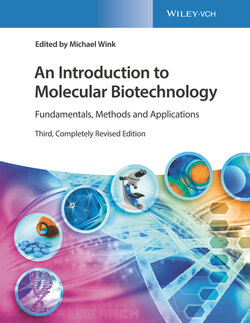Читать книгу An Introduction to Molecular Biotechnology - Группа авторов - Страница 23
3.1.1.1 Membrane Permeability
ОглавлениеBiomembranes serve primarily as permeability barriers. The lipophilic inside of the membrane is an effective barrier against the diffusion of polar and charged substances, while membrane proteins enable the controlled import and export of ions and metabolites. The effectiveness of the membrane as a permeability barrier becomes apparent when looking at the difference in ion concentrations inside and outside a cell (Table 3.1). The differences in ion concentration may be as large as several powers of 10.
Table 3.1 Ion concentrations inside mammalian cells and in the extracellular space.
| Ion | Intracellular concentration | Extracellular concentration |
|---|---|---|
| Cations | ||
| Na+ | 5–15 mM | 145 mM |
| K+ | 140 mM | 5 mM |
| Mg++ | 0.5 mMa) | 1–2 mM |
| Ca++ | 100 nMa) | 1–2 mM |
| H+ | 10−7.2 M(=pH 7.2) | 10−7.4 M(=pH 7.4) |
| Anions | ||
| Cl− | 5–15 mM | 110 mM |
a) Ca++ and Mg++ also occur bound to proteins within the cell (1–2 mM or 20 mM, respectively).
Figure 3.4 shows a schematic view of the barrier function, using the example of an artificial lipid bilayer. Given sufficient time, any substance will diffuse through a membrane. The diffusion rate, however, varies considerably, depending on size, charge, and lipophilic properties of a molecule. The smaller and more hydrophobic a molecule is, the faster it will diffuse across a cell membrane. The following rules apply:
Smaller nonpolar molecules such as O2, CO2, and N2 are lipid soluble, diffusing rapidly through biomembranes. This is also true for lipophilic organic molecules such as benzene or chloroform. Many therapeutics are strongly lipophilic and can thus diffuse freely into the body.
Small uncharged polar molecules are slightly slower to diffuse through the membrane. This category includes molecules such as H2O, ethanol, urea, or glycerol.
The biomembrane forms an effective barrier to larger charged molecules (sugar, amino acids, and nucleotides).
Small charged inorganic ions such as Na+, K+, Ca2+, or Cl− are unable to permeate the lipid bilayer through free diffusion.
Figure 3.4 Permeability of artificial lipid membranes for biologically relevant substances.
Membrane permeability can be modified by certain agents. For example, bacteria are vulnerable to antimicrobial peptides (AMPs) and certain antibiotics, such as the peptide antibiotics tyrothricin, polymyxin B, gramicidin, and valinomycin or the polyene antibiotic amphotericin B. These substances act on the biomembrane and disrupt the ion balance specifically or nonspecifically; some are ionophores. Many plants produce saponins, which unselectively disturb membrane permeability. Furthermore, the effect of some inhaled anesthetics can be interpreted as a disturbance of the biomembrane and of the ion channels.
